您好,登錄后才能下訂單哦!
您好,登錄后才能下訂單哦!
本篇內容介紹了“Python文本預處理的方法是什么”的有關知識,在實際案例的操作過程中,不少人都會遇到這樣的困境,接下來就讓小編帶領大家學習一下如何處理這些情況吧!希望大家仔細閱讀,能夠學有所成!
將文本中出現的字母轉化為小寫
示例1:將字母轉化為小寫
Python 實現代碼:
input_str = ”The 5 biggest countries by population in 2017 are China, India, United States, Indonesia, and Brazil.” input_strinput_str = input_str.lower() print(input_str)
輸出:
the 5 biggest countries by population in 2017 are china, india, united states, indonesia, and brazil.
刪除文本中出現的數字
如果文本中的數字與文本分析無關的話,那就刪除這些數字。通常,正則化表達式可以幫助你實現這一過程。
示例2:刪除數字
Python 實現代碼:
import re input_str = ’Box A contains 3 red and 5 white balls, while Box B contains 4 red and 2 blue balls.’ reresult = re.sub(r’\d+’, ‘’, input_str) print(result)
輸出:
Box A contains red and white balls, while Box B contains red and blue balls.
刪除文本中出現的標點
以下示例代碼演示如何刪除文本中的標點符號,如 [!”#$%&’()*+,-./:;<=>?@[\]^_`{|}~] 等符號。
示例3:刪除標點
Python 實現代碼:
import string input_str = “This &is [an] example? {of} string. with.? punctuation!!!!” # Sample string result = input_str.translate(string.maketrans(“”,””), string.punctuation) print(result)輸出:
This is an example of string with punctuation
刪除文本中出現的空格
可以通過 strip()函數移除文本前后出現的空格。
示例4:刪除空格
Python 實現代碼:
input_str = “ \t a string example\t “ input_strinput_str = input_str.strip() input_str
輸出:
‘a string example’
符號化(Tokenization)
符號化是將給定的文本拆分成每個帶標記的小模塊的過程,其中單詞、數字、標點及其他符號等都可視為是一種標記。在下表中(Tokenization sheet),羅列出用于實現符號化過程的一些常用工具。
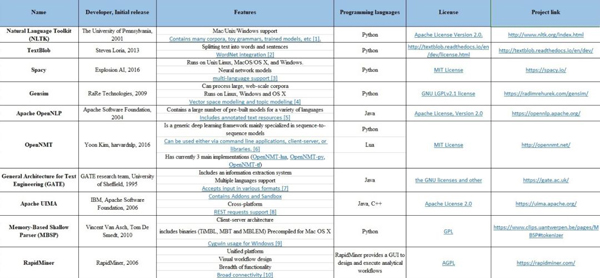
刪除文本中出現的終止詞
終止詞(Stop words) 指的是“a”,“a”,“on”,“is”,“all”等語言中最常見的詞。這些詞語沒什么特別或重要意義,通常可以從文本中刪除。一般使用 Natural Language Toolkit(NLTK) 來刪除這些終止詞,這是一套專門用于符號和自然語言處理統計的開源庫。
示例7:刪除終止詞
實現代碼:
input_str = “NLTK is a leading platform for building Python programs to work with human language data.” stop_words = set(stopwords.words(‘english’)) from nltk.tokenize import word_tokenize tokens = word_tokenize(input_str) result = [i for i in tokens if not i in stop_words] print (result)
輸出:
[‘NLTK’, ‘leading’, ‘platform’, ‘building’, ‘Python’, ‘programs’, ‘work’, ‘human’, ‘language’, ‘data’, ‘.’]
此外,scikit-learn 也提供了一個用于處理終止詞的工具:
from sklearn.feature_extraction.stop_words import ENGLISH_STOP_WORDS
同樣,spaCy 也有一個類似的處理工具:
from spacy.lang.en.stop_words import STOP_WORDS
刪除文本中出現的稀疏詞和特定詞
在某些情況下,有必要刪除文本中出現的一些稀疏術語或特定詞。考慮到任何單詞都可以被認為是一組終止詞,因此可以通過終止詞刪除工具來實現這一目標。
詞干提取(Stemming)
詞干提取是一個將詞語簡化為詞干、詞根或詞形的過程(如 books-book,looked-look)。當前主流的兩種算法是 Porter stemming 算法(刪除單詞中刪除常見的形態和拐點結尾) 和 Lancaster stemming 算法。
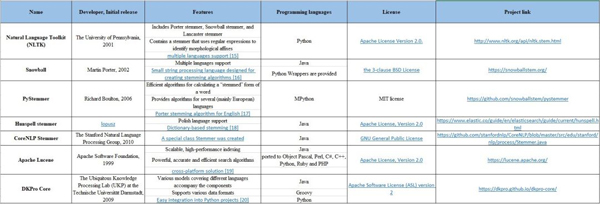
示例 8:使用 NLYK 實現詞干提取
實現代碼:
from nltk.stem import PorterStemmer from nltk.tokenize import word_tokenize stemmer= PorterStemmer() input_str=”There are several types of stemming algorithms.” input_str=word_tokenize(input_str) for word in input_str: print(stemmer.stem(word))
輸出:
There are sever type of stem algorithm.
詞形還原(Lemmatization)
詞形還原的目的,如詞干過程,是將單詞的不同形式還原到一個常見的基礎形式。與詞干提取過程相反,詞形還原并不是簡單地對單詞進行切斷或變形,而是通過使用詞匯知識庫來獲得正確的單詞形式。
當前常用的詞形還原工具庫包括: NLTK(WordNet Lemmatizer),spaCy,TextBlob,Pattern,gensim,Stanford CoreNLP,基于內存的淺層解析器(MBSP),Apache OpenNLP,Apache Lucene,文本工程通用架構(GATE),Illinois Lemmatizer 和 DKPro Core。
示例 9:使用 NLYK 實現詞形還原
實現代碼:
from nltk.stem import WordNetLemmatizer from nltk.tokenize import word_tokenize lemmatizer=WordNetLemmatizer() input_str=”been had done languages cities mice” input_str=word_tokenize(input_str) for word in input_str: print(lemmatizer.lemmatize(word))
輸出:
be have do language city mouse
詞性標注(POS)
詞性標注旨在基于詞語的定義和上下文意義,為給定文本中的每個單詞(如名詞、動詞、形容詞和其他單詞) 分配詞性。當前有許多包含 POS 標記器的工具,包括 NLTK,spaCy,TextBlob,Pattern,Stanford CoreNLP,基于內存的淺層分析器(MBSP),Apache OpenNLP,Apache Lucene,文本工程通用架構(GATE),FreeLing,Illinois Part of Speech Tagger 和 DKPro Core。
示例 10:使用 TextBlob 實現詞性標注
實現代碼:
input_str=”Parts of speech examples: an article, to write, interesting, easily, and, of” from textblob import TextBlob result = TextBlob(input_str) print(result.tags)
輸出:
[(‘Parts’, u’NNS’), (‘of’, u’IN’), (‘speech’, u’NN’), (‘examples’, u’NNS’), (‘an’, u’DT’), (‘article’, u’NN’), (‘to’, u’TO’), (‘write’, u’VB’), (‘interesting’, u’VBG’), (‘easily’, u’RB’), (‘and’, u’CC’), (‘of’, u’IN’)]
詞語分塊(淺解析)
詞語分塊是一種識別句子中的組成部分(如名詞、動詞、形容詞等),并將它們鏈接到具有不連續語法意義的高階單元(如名詞組或短語、動詞組等) 的自然語言過程。常用的詞語分塊工具包括:NLTK,TreeTagger chunker,Apache OpenNLP,文本工程通用架構(GATE),FreeLing。
示例 11:使用 NLYK 實現詞語分塊
第一步需要確定每個單詞的詞性。
實現代碼:
input_str=”A black television and a white stove were bought for the new apartment of John.” from textblob import TextBlob result = TextBlob(input_str) print(result.tags)
輸出:
[(‘A’, u’DT’), (‘black’, u’JJ’), (‘television’, u’NN’), (‘and’, u’CC’), (‘a’, u’DT’), (‘white’, u’JJ’), (‘stove’, u’NN’), (‘were’, u’VBD’), (‘bought’, u’VBN’), (‘for’, u’IN’), (‘the’, u’DT’), (‘new’, u’JJ’), (‘apartment’, u’NN’), (‘of’, u’IN’), (‘John’, u’NNP’)]
二部就是進行詞語分塊
實現代碼:
reg_exp = “NP: {<DT>?<JJ>*<NN>}” rp = nltk.RegexpParser(reg_exp) result = rp.parse(result.tags) print(result)輸出:
(S (NP A/DT black/JJ television/NN) and/CC (NP a/DT white/JJ stove/NN) were/VBD bought/VBN for/IN (NP the/DT new/JJ apartment/NN) of/IN John/NNP)
也可以通過 result.draw() 函數繪制句子樹結構圖,如下圖所示。

命名實體識別(Named Entity Recognition)
命名實體識別(NER) 旨在從文本中找到命名實體,并將它們劃分到事先預定義的類別(人員、地點、組織、時間等)。
常見的命名實體識別工具如下表所示,包括:NLTK,spaCy,文本工程通用架構(GATE) -- ANNIE,Apache OpenNLP,Stanford CoreNLP,DKPro核心,MITIE,Watson NLP,TextRazor,FreeLing 等。
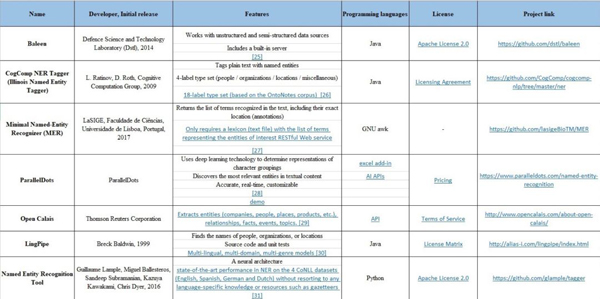
示例 12:使用 TextBlob 實現詞性標注
實現代碼:
from nltk import word_tokenize, pos_tag, ne_chunk input_str = “Bill works for Apple so he went to Boston for a conference.” print ne_chunk(pos_tag(word_tokenize(input_str)))
輸出:
(S (PERSON Bill/NNP) works/VBZ for/IN Apple/NNP so/IN he/PRP went/VBD to/TO (GPE Boston/NNP) for/IN a/DT conference/NN ./.)
共指解析 Coreference resolution(回指分辨率 anaphora resolution)
代詞和其他引用表達應該與正確的個體聯系起來。Coreference resolution 在文本中指的是引用真實世界中的同一個實體。如在句子 “安德魯說他會買車”中,代詞“他”指的是同一個人,即“安德魯”。常用的 Coreference resolution 工具如下表所示,包括 Stanford CoreNLP,spaCy,Open Calais,Apache OpenNLP 等。
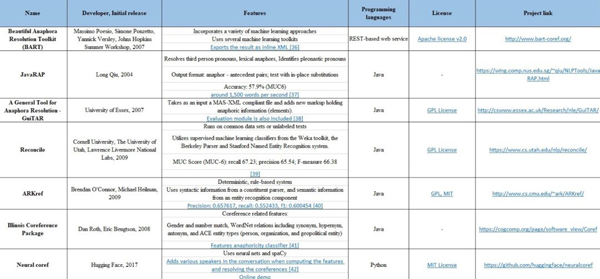
搭配提取(Collocation extraction)
搭配提取過程并不是單獨、偶然發生的,它是與單詞組合一同發生的過程。該過程的示例包括“打破規則 break the rules”,“空閑時間 free time”,“得出結論 draw a conclusion”,“記住 keep in mind”,“準備好 get ready”等。
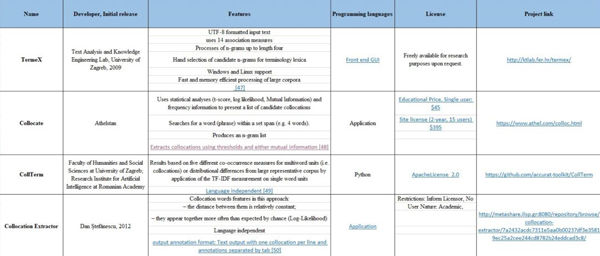
示例 13:使用 ICE 實現搭配提取
實現代碼:
input=[“he and Chazz duel with all keys on the line.”] from ICE import CollocationExtractor extractor = CollocationExtractor.with_collocation_pipeline(“T1” , bing_key = “Temp”,pos_check = False) print(extractor.get_collocations_of_length(input, length = 3))
輸出:
[“on the line”]
關系提取(Relationship extraction)
關系提取過程是指從非結構化的數據源 (如原始文本)獲取結構化的文本信息。嚴格來說,它確定了命名實體(如人、組織、地點的實體) 之間的關系(如配偶、就業等關系)。例如,從“昨天與 Mark 和 Emily 結婚”這句話中,我們可以提取到的信息是 Mark 是 Emily 的丈夫。
“Python文本預處理的方法是什么”的內容就介紹到這里了,感謝大家的閱讀。如果想了解更多行業相關的知識可以關注億速云網站,小編將為大家輸出更多高質量的實用文章!
免責聲明:本站發布的內容(圖片、視頻和文字)以原創、轉載和分享為主,文章觀點不代表本網站立場,如果涉及侵權請聯系站長郵箱:is@yisu.com進行舉報,并提供相關證據,一經查實,將立刻刪除涉嫌侵權內容。